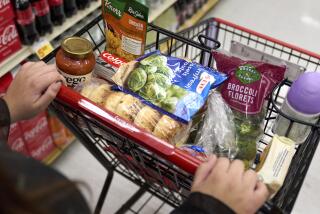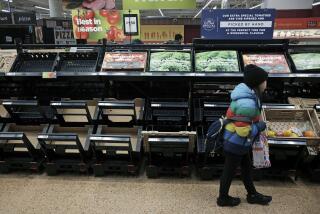Number of Items Displayed Triples in Decade : Demand for Fresh Produce Changes Markets
- Share via
LAS VEGAS — Americans are taking a fresher approach to their eating habits these days: On average, every man, woman and child ate 26 more pounds of fresh fruits and vegetables last year than they did 10 years before. This increased demand for fresh produce is transforming the nation’s supermarkets, altering relations between retailers and wholesalers and beginning to force commodity-oriented farmers to tailor crops to a variety-oriented marketplace.
U.S. Department of Agriculture statistics show that average consumption of fresh vegetables increased about 1% a year in each of the last nine years, and is expected to continue to grow this year. The department attributed the growth to an “increased awareness of the beneficial health effects of vegetable consumption and the expected increases in supply and numbers of new products available.”
And a survey conducted for the Wheat Industry Council concluded: “More and more people are substituting fresh fruit and vegetables for doughnuts, fruit pies and snack cakes.”
As a result, the number of fresh-produce items found in the nation’s supermarkets more than tripled over the last decade, from 65 items in 1974 to 216 last year, according to a survey by the Produce Marketing Assn. “People continue to be crazy about new items,” said Paul Campbell of the Packer, a trade journal published in Shawnee Mission, Mo., that surveyed shoppers’ produce-buying habits last year.
Las Vegas Meeting
These changes provide “real food for thought for the produce industry,” quipped Thomas R. Pierson, a Michigan State University agricultural economist, speaking to the United Fresh Fruit & Vegetable Assn., which held its 81st annual meeting at the Las Vegas Hilton last week.
“There’s a lot happening in the produce industry,” agreed Edward W. McLaughlin, a Cornell University agricultural economist who joined Pierson to outline trends and opportunities in produce marketing. Consumers are moving away from their traditional emphasis on price to “an increasing value orientation,” a greater appreciation of quality and value, and increased willingness to try new items.
“This is a dramatic shift, . . . creating fundamental changes in the fresh produce industry,” McLaughlin said.
Today’s consumers at both ends of the age spectrum emphasize “lighter and healthier” diets than the meat-and-potatoes regimen favored by earlier generations, the economists said. In addition, the combination of more leisure time, more two-income families and fewer children in families reduces the importance of shopping strictly for best buys and tends to complicate any consumer profile, fragmenting the once-dominant image of the homemaker-shopper into a spectrum of “shopper segments,” they said.
Adding Color or Contrast
Red peppers may be more expensive than green peppers, for example, but they sell in increasing volume because more consumers are willing to pay the price--if only to add color or contrast to a dish.
Efforts by retailers to meet the demand for more and more varied stocks of fresh fruits and vegetables have elevated produce departments to star status, rivaling and even dislodging the red-meat department. Not only did produce departments increase floor space 25% in just four years, but they also became “the most exciting part of the store,” designed to draw customers into the store by offering “exciting” and colorful displays of fresh fruits and vegetables, Pierson said.
Supermarkets now often contain their own delicatessens and bakeries, produce departments may include “salad bars” where customers can buy assorted vegetables ready for the salad bowl, and produce managers make a far greater effort to introduce new items to their consumers, along with information on nutrition and use, the economists said. Not only are the kinds, sizes and varieties of produce items increasing in number, they went on, but once-seasonal fruits and vegetables are also becoming available on a year-round basis, thanks to imports from New Zealand, Chile and other Southern Hemisphere producing countries.
In contrast, 1960’s typical supermarket offered little variety beyond the staples in produce, frozen foods were the rage, and bread choice was limited to loaves of brown, white and sometimes rye.
Broccoli Up 169%
The increase in consumption varies widely from vegetable to vegetable, Pierson said: Broccoli consumption rose 169% in less than a decade, carrots 7%, green peppers 24%, spinach 80%, cauliflower 100%, cucumbers 38% and onions 19%. Among fruits, consumption of grapes increased 117%, apples 12%, nectarines 71%, pears 21% and strawberries 41%; plums, on the other hand, merely held even. (“Have you tried eating one?” a wholesaler muttered. “Fix the flavor and they’ll sell.”)
“These numbers are of increasingly less value in helping us make marketing decisions,” Pierson said. More detailed data is needed to point out which varieties of each fruit and vegetable sell best and to which shopper segment.
While it is true that 10 staples still account for almost 80% of all produce sales, Pierson explained, those staples break down into dozens of kinds and sizes of potatoes, onions, carrots and other produce items. “Look at the multiples and differentiated offerings of produce items,” he advised. “The key word here is differentiated .”
Supermarkets no longer offer just “tomatoes,” for example, but tomatoes sold in bulk, packaged tomatoes, cherry tomatoes in baskets and hydroponically grown tomatoes wrapped in cellophane; carrots may be large or small, with tops or without, packaged or in bulk; and onions are proliferating in kind as well as presentation, offered in sacks, heaped in bins, bags and boxes, peeled and clear-wrapped in plastic.
Individual Needs
These varied presentations tend to increase the value of the item to the consumer by offering a product that meets individual needs, the economists said.
Efforts by supermarkets to keep up with customers’ changing tastes have increased the produce departments’ share of total store sales 9%, McLaughlin said, and more “market-driven” outlets have seen 12%-to-18% growth in sales volume. One Ralphs supermarket in Manhattan Beach, for example, claims to do greater volume in produce sales than meat during certain weeks in the year, a finding quickly echoed by a representative of Compton-based Vons Grocery Co.and also by a Midwestern chain.
“This is not simply a West Coast phenomenon,” McLaughlin said. “The produce phenomenon is really sweeping the country.”
Computer-controlled inventory systems enhance the ability of grocers to analyze what’s happening in their produce sections and order accordingly. More than one-third of the nation’s supermarkets are now computer-equipped, Pierson said.
Oversupply Possible
So far, McLaughlin added, improved productivity has enabled growers to “easily” satisfy increased demand for fresh produce. This could result in problems of oversupply if demand is overestimated, as it was in the wine industry, he warned.
Marketing based on careful and continuous research is the key to survival in the second half of the 1980s, from growers to retailers, the economists said. The pronounced shift toward consumer-responsiveness is affecting not just wholesaler-retailer relations but grower-shipper relations as well, the economists predicted: Farmers accustomed to growing crops as “commodities” will have to adjust plantings to the marketplace.
“Historically, produce marketing firms, especially shippers, have tended to be source-related and supply-driven rather than customer- and shopper-oriented,” McLaughlin and Pierson wrote in a recent report on the produce industry. “This production orientation emphasizes the produce, not customers and not shoppers. It focuses on selling to stay in business, instead of marketing to customers’ wants and needs.
“A marketing orientation, in contrast, consists of identifying customers’ wants and needs and taking actions to satisfy them,” they explained.
Speaking to the produce-industry audience here, Pierson said: “The produce industry has been commodity oriented. Stronger marketing is essential.”
Annual Per Capita Consumption of Fresh Produce In Pounds
1973 1974 1975 1976 1977 1978 Vegetables 89.8 91.6 90.3 92.9 93.6 95.4 Fruits 75.2 76.7 82.1 81.3 79.4 80.6 Total 165.0 168.3 172.4 174.2 173.0 176.0
1979 1980 1981 1982 1983 1984** Vegetables 96.4 98.8 96.2 100.1 99.9 100.0 Fruits 81.2 86.8 84.0 84.3 91.8 90.0 Total 177.6 185.6 180.2 184.4 191.7 190.0
**Estimated Source: USDA Economic Research Service
More to Read
Eat your way across L.A.
Get our weekly Tasting Notes newsletter for reviews, news and more.
You may occasionally receive promotional content from the Los Angeles Times.







